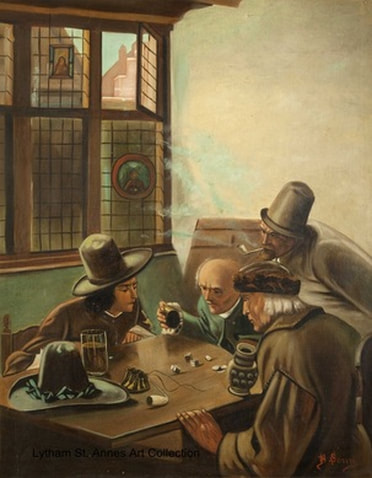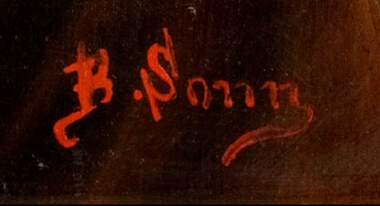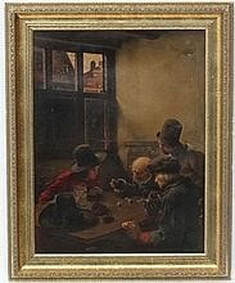The Dice Throwers
|
Research by Ayla Shearer and Marjorie Gregson
|
|
Acc No 13
Artist B Sonn after Claus Meyer (1856-1919) Artist dates active 19th century Medium oil on panel Size 66.0 x 53.3 cm (26 x 21 in) Date painted unknown Donor Mrs Agnes E Kirby, nee Webster, 1879-1962 14 Lawrence Avenue, St Annes Date donated 28 November 1949 |
PAINTING
Here, the dice thrower and surrounding men play an historical game in a public house. The intensity of the playing is expressed through the stances of the figures poised over the table and Sonn's dramatic use of perspective. A high, open window draws pipe-smoke upwards and objects appear unsteady, almost rocking. Could these be travellers breaking their journeys?
ARTIST
We have been unable to discover anything about this artist. The Public Catalogue Foundation attributes this to American artist, Albert H Sonn (1867-1936), but his style is very different. This painting has a very distinctive signature of B Sonn, quite unlike that of Albert H Sonn.
After searching without success for information about the artist B Sonn our most recent research revealed that the painting was a copy of Die Wurfelspieler, 1885, by the German artist, Claus Meyer.
August Eduard Nikolaus Meyer (1856-1919) was born in Linden, near Hanover, and studied at the Nuremberg School of Art and the Munich Academy, becoming a professor at the Karlsruhe Academy and later at the Dusseldorf Academy. He was a genre painter of renown and recognised for his compelling portraits and interiors.
Among his best known works is The Dice Players, which was created in 1885, and copied in smaller variants.
Here, the dice thrower and surrounding men play an historical game in a public house. The intensity of the playing is expressed through the stances of the figures poised over the table and Sonn's dramatic use of perspective. A high, open window draws pipe-smoke upwards and objects appear unsteady, almost rocking. Could these be travellers breaking their journeys?
ARTIST
We have been unable to discover anything about this artist. The Public Catalogue Foundation attributes this to American artist, Albert H Sonn (1867-1936), but his style is very different. This painting has a very distinctive signature of B Sonn, quite unlike that of Albert H Sonn.
After searching without success for information about the artist B Sonn our most recent research revealed that the painting was a copy of Die Wurfelspieler, 1885, by the German artist, Claus Meyer.
August Eduard Nikolaus Meyer (1856-1919) was born in Linden, near Hanover, and studied at the Nuremberg School of Art and the Munich Academy, becoming a professor at the Karlsruhe Academy and later at the Dusseldorf Academy. He was a genre painter of renown and recognised for his compelling portraits and interiors.
Among his best known works is The Dice Players, which was created in 1885, and copied in smaller variants.
His pictures are often “arranged in a stage-like box room and were often based on Dutch interior paintings of the 17th century.
The back lit view through the windows refers to this tradition.” Teja Hohensee.
REFERENCE
www.dewezet.de
The back lit view through the windows refers to this tradition.” Teja Hohensee.
REFERENCE
www.dewezet.de




